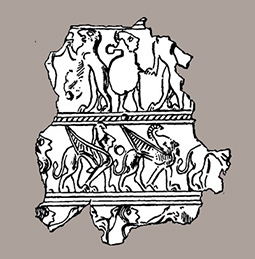download article as .pdf: A Bronze Belt from Kavousi
This work is aimed to re-analyse figured bronze fragments found in the tholos tomb at Kavousi (Crete) by Harriet Boyd in 1900. Since the time of the discovery, the “Kavousi Bronze Plaque” was at the centre of several studies concerning artistic relationships and reciprocal influences between Aegean, Crete in particular, and Near East in the early 1st millennium BC. Interest was mostly addressed to the rich figural decoration through parallel registers, formed by subjects (lords of the animals, sphinxes, griffins) belonging to the Oriental iconographic repertoire but, contemporaneously, well attested in early Iron Age Crete. The attention focused on the plate’s decorative pattern, which has comparisons from other sites of the island (Knossos, Idaean Cave, Eleutherna, Prinias) made almost neglected the nature of the object itself, fundamental for the reconstruction of its meaning. Through the exam of decorative features, the fragments’ borders and the characteristic distribution of the holes along the plate’s rims, and thanks to systematic comparisons with the contemporary Eastern production, it is possible and plausible as well to reconstruct the “Kavousi plate” as a belt. This would be inspired by a Urartian prototype of 9th/8th cent. BC, later quite spread though neighbour Eastern Mediterranean regions.

